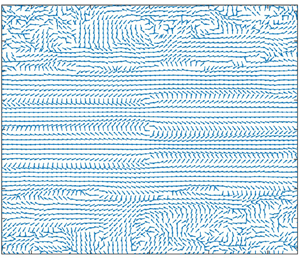Published online by Cambridge University Press: 23 March 2023

Measurements were made in rough-wall boundary layers subject to favourable, zero and adverse pressure gradients. Profiles of mean velocity and turbulence quantities were acquired and velocity fields were measured in multiple planes to document flow structure. Comparisons were made to equivalent smooth-wall cases with the same free stream velocity distributions. Outer layer similarity was observed between the rough- and smooth-wall cases in all quantities in the favourable and zero pressure gradient regions, but large differences were observed with adverse pressure gradients. In both the smooth- and rough-wall cases, the favourable pressure gradient reduced the turbulence in the boundary layer, and increased the size of turbulence structures relative to the boundary layer thickness in both the streamwise and spanwise directions, while lowering their inclination angle with respect to the wall. When the boundary layer was returned to a zero pressure gradient following the favourable pressure gradient region, the turbulence level and the size and inclination of the structures returned to their canonical zero pressure gradient condition. The response of the boundary layer was somewhat faster in the rough-wall case, causing it to reach equilibrium in a shorter streamwise distance after the changes in pressure gradient than in the smooth-wall case. The adverse pressure gradient increased turbulence levels relative to the wall friction velocity, reduced the size of turbulence structures relative to the boundary layer thickness and increased their inclination angle. The changes with the adverse pressure gradient were significantly larger with the rough wall than the smooth. The results suggest that similarity might be achieved with adverse pressure gradients if smooth- and rough-wall cases with the same Clauser pressure gradient parameter history are compared.